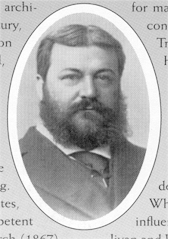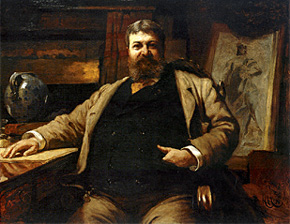Born at the Priestley Plantation in St. James Parish, Louisiana, Henry Hobson Richardson was the great-grandson of Joseph Priestley, who is credited with the discovery of oxygen.
Richardson studied at Tulane and Harvard Universities. His interest in civil engineering shifted to architecture, and he continued his studies at the Ecole des Beaux-Arts in Paris. Because of his family's financial difficulties during the Civil War, he was unable to complete his studies there and returned to the United States in 1865.
He began working with the Romanesque style that he had encountered in southern France. His noted works include Trinity Church, Boston; the New York State Capitol Building, Albany; the Allegheny County Courthouse, Pittsburgh, PA; and the Marshall Field Wholesale Store, Chicago.
Richardson died in the Brookline area, at the age of 47, of Bright's disease (nephritis).
He is buried in the family plot near where he lived most of his life.
From Architects' Gravesites by Henry H. Kuehl, c. 2017, p. 83.
Submitted by Member Angela (#48520699), member of the Pittsburgh History and Landmarks Foundation.
______________________________________
25 Cottage Street in Brookline, Massachusetts, was home to one of the most influential and legendary architects in American history, Henry Hobson Richardson (1838-1886.) Along with Louis Sullivan and Frank Lloyd Wright, Richardson is one of "the recognized trinity of American architecture."
Immortalized across the country through his namesake Richardsonian Romanesque style, Richardson's work solidified an American architectural vocabulary in the years following the Civil War and trained a new generation of professional architects who would transform the country's built environment through the early decades of the twentieth century.
His work, an attempt to discipline the English Picturesque style by combining it with the Medieval French Romanesque, is characterized by mass, order and repose. Well known examples of his work include Boston's Trinity Church, Sever Hall at Harvard University, Chicago's Glessner House and the New York State Capitol in Albany. Two of his best-loved buildings, the Allegheny County Courthouse in Pittsburgh and the Marshall Field Wholesale Store in Chicago, demolished in 1930, were completed posthumously by his assistants.
The style he pioneered is distinguished by robust stone buildings, usually with a distinctive sculptural shape, an interplay of symmetry and asymmetry in massing, and heavy and dramatic features such as semi-circular arches, deep openings and windows, and rusticated stone with contrasting color or texture. The distinctive version of the Romanesque Revival that Richardson popularized can be seen in various forms in communities across North America.
A large figure with a personality to match, Richardson intentionally chose to live and work outside of Boston in a "Jamaica planter's" or West Indian style house that alludes to his youth spent on a sugar plantation in Louisiana. Richardson maintained a complicated relationship with his Southern heritage, having moved north to attend Harvard as a young man and being persuaded by his peers not to enlist in the Confederate Army during the Civil War. Richardson instead traveled to France to study for as long as his family's money could support him, returning to the U.S. in 1865 to establish himself as an architect in the prosperous northern states. In 1874, he rented the Brookline house from his friend Edward W. Hooper and established his office and library in the parlors on the first floor.
Although his impact was enormous, Richardson's professional career was relatively short. After he passed away, his wife, Julia Gorham Hayden, was able to purchase their rented home. The house was kept very intact, including much of the finishes and furniture from Richardson's lifetime. It remained with Richardson's descendants until the passing of Richardson's grandson at the turn of the twenty-first century. Since then, neighbors, friends and preservation organizations have pursued a twenty-year effort to ensure the property is preserved. While the efforts have been successful in short increments, they have not resulted in robust, permanent protection for this nationally significant house.
Unfortunately, in November of 2020, the property and its neighbors at 39 Cottage and 222 Warren (the 1857 home of John Charles Olmsted) were acquired by a developer who quickly filed an application to demolish the Richardson House.
The Brookline Preservation Commission will hold a Demolition Delay hearing on December 29 to decide whether to impose an 18-month stay on demolition.
The Richardson House is a significant part of our collective cultural history and represents not just the legacy of Richardson as perhaps the most important architect in U.S. history, but the complex and interesting man and the family behind the legacy. It is the physical embodiment of the idea that greatness can be achieved by imperfect people, living and working together in borrowed houses.
~ by Regina Cole Contributor to Forbes Magazine
"I think old houses, and the people who love them, are fascinating."
Born at the Priestley Plantation in St. James Parish, Louisiana, Henry Hobson Richardson was the great-grandson of Joseph Priestley, who is credited with the discovery of oxygen.
Richardson studied at Tulane and Harvard Universities. His interest in civil engineering shifted to architecture, and he continued his studies at the Ecole des Beaux-Arts in Paris. Because of his family's financial difficulties during the Civil War, he was unable to complete his studies there and returned to the United States in 1865.
He began working with the Romanesque style that he had encountered in southern France. His noted works include Trinity Church, Boston; the New York State Capitol Building, Albany; the Allegheny County Courthouse, Pittsburgh, PA; and the Marshall Field Wholesale Store, Chicago.
Richardson died in the Brookline area, at the age of 47, of Bright's disease (nephritis).
He is buried in the family plot near where he lived most of his life.
From Architects' Gravesites by Henry H. Kuehl, c. 2017, p. 83.
Submitted by Member Angela (#48520699), member of the Pittsburgh History and Landmarks Foundation.
______________________________________
25 Cottage Street in Brookline, Massachusetts, was home to one of the most influential and legendary architects in American history, Henry Hobson Richardson (1838-1886.) Along with Louis Sullivan and Frank Lloyd Wright, Richardson is one of "the recognized trinity of American architecture."
Immortalized across the country through his namesake Richardsonian Romanesque style, Richardson's work solidified an American architectural vocabulary in the years following the Civil War and trained a new generation of professional architects who would transform the country's built environment through the early decades of the twentieth century.
His work, an attempt to discipline the English Picturesque style by combining it with the Medieval French Romanesque, is characterized by mass, order and repose. Well known examples of his work include Boston's Trinity Church, Sever Hall at Harvard University, Chicago's Glessner House and the New York State Capitol in Albany. Two of his best-loved buildings, the Allegheny County Courthouse in Pittsburgh and the Marshall Field Wholesale Store in Chicago, demolished in 1930, were completed posthumously by his assistants.
The style he pioneered is distinguished by robust stone buildings, usually with a distinctive sculptural shape, an interplay of symmetry and asymmetry in massing, and heavy and dramatic features such as semi-circular arches, deep openings and windows, and rusticated stone with contrasting color or texture. The distinctive version of the Romanesque Revival that Richardson popularized can be seen in various forms in communities across North America.
A large figure with a personality to match, Richardson intentionally chose to live and work outside of Boston in a "Jamaica planter's" or West Indian style house that alludes to his youth spent on a sugar plantation in Louisiana. Richardson maintained a complicated relationship with his Southern heritage, having moved north to attend Harvard as a young man and being persuaded by his peers not to enlist in the Confederate Army during the Civil War. Richardson instead traveled to France to study for as long as his family's money could support him, returning to the U.S. in 1865 to establish himself as an architect in the prosperous northern states. In 1874, he rented the Brookline house from his friend Edward W. Hooper and established his office and library in the parlors on the first floor.
Although his impact was enormous, Richardson's professional career was relatively short. After he passed away, his wife, Julia Gorham Hayden, was able to purchase their rented home. The house was kept very intact, including much of the finishes and furniture from Richardson's lifetime. It remained with Richardson's descendants until the passing of Richardson's grandson at the turn of the twenty-first century. Since then, neighbors, friends and preservation organizations have pursued a twenty-year effort to ensure the property is preserved. While the efforts have been successful in short increments, they have not resulted in robust, permanent protection for this nationally significant house.
Unfortunately, in November of 2020, the property and its neighbors at 39 Cottage and 222 Warren (the 1857 home of John Charles Olmsted) were acquired by a developer who quickly filed an application to demolish the Richardson House.
The Brookline Preservation Commission will hold a Demolition Delay hearing on December 29 to decide whether to impose an 18-month stay on demolition.
The Richardson House is a significant part of our collective cultural history and represents not just the legacy of Richardson as perhaps the most important architect in U.S. history, but the complex and interesting man and the family behind the legacy. It is the physical embodiment of the idea that greatness can be achieved by imperfect people, living and working together in borrowed houses.
~ by Regina Cole Contributor to Forbes Magazine
"I think old houses, and the people who love them, are fascinating."
Family Members
Advertisement
Explore more
Sponsored by Ancestry
Advertisement
















